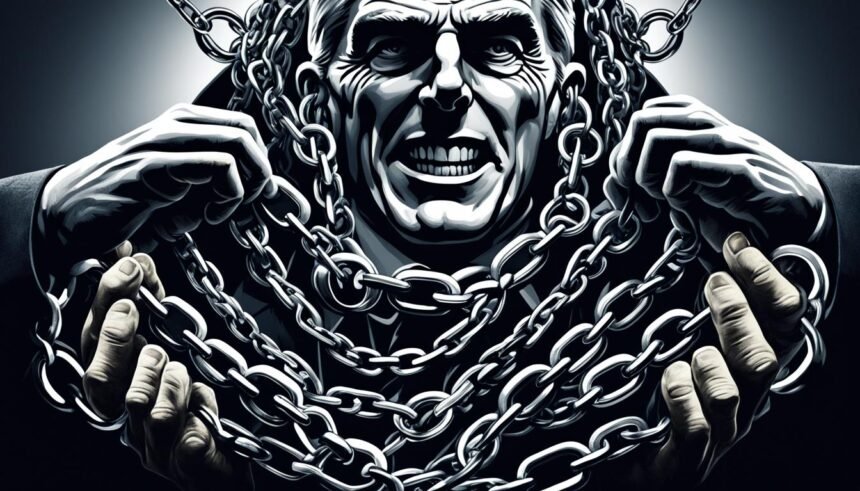Autocratic leadership is like a one-man show. The leader does everything and doesn’t ask their team for ideas. Autocratic leaders often do what they think is right without taking advice. They keep a tight grip, making all decisions without waiting for anyone else.
This way of leading has its pros and cons. Being too autocratic can make you look bad, like a dictator. But, in some cases, being in full control can help get things done quickly and efficiently.
Key Takeaways
- Autocratic leadership is a highly centralized, top-down approach to management and decision-making.
- Autocratic leaders exert complete control over their teams, leaving little room for employee autonomy or input.
- This leadership style can be effective in crisis situations or where quick, decisive action is required.
- However, autocratic leadership can also negatively impact employee morale and stifle creativity.
- Balancing autocratic leadership with more collaborative approaches is often the most successful strategy.
What is Autocratic Leadership?
Autocratic leadership, also known as authoritarian leadership, is a style where the leader has full control. They don’t often ask for help or ideas from the team. Instead, they make decisions based on their own thoughts. This means they fully control the group.
Definition and Key Traits
Autocratic leaders decide everything with little or no help from others. They set strict rules and procedures. This leaves little space for team members to show creativity or make their own decisions. Their top-down approach limits other people’s input.
Individual Control over Decisions
Autocratic leaders mostly make decisions by themselves. They don’t involve their team much. This keeps a strong hold on the group but might stop new ideas or full team participation.
Limited Input from Group Members
In autocratic leadership, team members rarely get to share their thoughts. The leader makes all the choices. This doesn’t promote working together to solve problems or take on tasks as a team.
Primary Characteristics of Autocratic Leaders
Autocratic leaders have distinct traits that make them stand out. They lead with top-down control and communication. Such leaders usually decide things alone.
Little to No Input from Team
Team members get little say in autocratic settings. Leaders often make decisions alone, without team opinions. This can make employees feel powerless and unheard.
Leaders Make Most Decisions
Autocratic leaders keep decision power to themselves. They don’t often let team members make important choices. This shows a clear top-down decision-making pattern in such leadership.
Ability to Dictate Work Methods
These leaders also control how tasks are done. They might tell employees exactly how to do their work. This can limit creative freedom and job satisfaction.
Highly Structured and Rigid Environments
Top-down leaders create strict work atmospheres. They set clear rules and expect strict adherence. This approach can limit team members’ freedom to work in their preferred ways.
Autocratic leaders run tight ships, with limited input from others. They prefer micromanaging and strict rules. Such an approach can make workplaces feel stifling and reduce creativity.
Types of Autocratic Leadership
Autocratic leadership isn’t just one style; it’s a broad type with different forms. The three main kinds are the directive (rigid), permissive (a bit flexible), and the paternalistic (strict but caring). Each has its own way of handling things.
Directive (Rigid) Style
The most controlling style is the directive one. Here, the leader tightly controls all decisions without much input from others. They set the work methods, rules, and expect obedience. While this leads to fast decisions, it can stop employees from being creative or fully engaged.
Permissive (Slightly Flexible) Style
Being a bit more flexible, the permissive style allows some feedback from those lower down. The leader still holds the power and most say, keeping a clear top-to-bottom structure. Hence, it’s a more approachable version of autocratic leadership than the very strict one.
Paternalistic (Strict but Caring) Style
In the paternalistic style, leaders are both firm and caring. They control decisions and guide processes while showing they care for their team. This can make employees feel loyal, but it might backfire if they think the concern is fake or used to get things done.
| Autocratic Leadership Style | Key Characteristics | Degree of Flexibility |
|---|---|---|
| Directive (Rigid) | – Leader maintains complete control over decision-making – Strict rules, procedures, and expectations of compliance | Low |
| Permissive (Slightly Flexible) | – Leader retains ultimate authority but allows some subordinate input – Maintains a top-down, hierarchical structure | Medium |
| Paternalistic (Strict but Caring) | – Authoritarian control combined with a sense of care/concern for employees – Leader acts as a parental figure | Medium-High |
Advantages of Autocratic Leadership
The autocratic leadership style is known for its top-down control. While it’s not for everyone, it does have its perks. The
Benefits of Autocratic Leadership
include:
Quick Decision-Making
Autocratic leaders make decisions fast on their own. They don’t always need to ask the team first. This way of working is great when quick decisions are needed, like in a crisis.
Clear Chain of Command
With autocratic leadership, everyone knows their place. It sets a clear hierarchical structure and a chain of command. This can make employees feel secure, especially in places that need rules followed closely.
Effective in Crisis Situations
The strong, top-down control in autocratic leadership shines during crises. In urgent times, a confident leader who acts fast can steer their team through rough waters.
Although autocratic leadership has downsides, its advantages of Autocratic Leadership show it can be helpful. It’s best in situations requiring swift decisions, clear direction, and a solid crisis plan.
Disadvantages of Autocratic Leadership
Autocratic leadership has benefits in some cases. Yet, it brings big problems too.
Discouraging group input is a key issue. Leaders often make choices alone, cutting off their teams. This leads to a lack of subordinate involvement. It also stops the team from sharing their wisdom and new ideas.
Bad morale is another big worry with autocratic styles. The strict top-down method can make team members unhappy. They might not feel listened to, and they may see little freedom in their work.
Also, these leaders often don’t listen to their team’s ideas. This choice to decide alone blocks creativity and innovation. And that can make it hard for the team to do well.
| Drawbacks of Autocratic Leadership | Impact |
|---|---|
| Discourages Group Input | Lack of Subordinate Involvement |
| Hurts Morale and Breeds Resentment | Negative Impacts on Morale |
| Ignores Expertise and Creative Solutions | Stifling of Creativity and Expertise |
Autocratic Leadership and Group Projects
Autocratic leadership can work well in group projects, especially when there’s a lack of clear leadership. This style is useful when a team is struggling with disorganization, can’t set deadlines, or seems lost. A strong autocratic leader can step in. They set tasks for each member and make sure deadlines are clear. This way, the group is more likely to finish the project on time, and everyone plays their part.
Autocratic Leadership in Group Projects becomes handy when the team lacks focus. An autocratic leader’s decisive, commanding style brings essential order and direction. This ensures the project stays on course, and every team member works towards success.
By using Task Assignment and Deadline Setting, an autocratic leader helps the group keep their eyes on the prize. This hands-on approach often leads to successful project outcomes. It can turn things around when working together just isn’t working.

When Autocratic Leadership Works Best
The autocratic style of leadership can be argued, but it has its place. It works well in stressful times that demand quick action. Industries such as manufacturing and construction benefit from this leadership. Here, clear tasks, deadlines, and safety rules are key.
Autocratic leadership shines when the leader knows the most. When the leader can make quick, smart choices, the team moves forward fast. This is crucial in urgent or risky situations. The leader uses their expertise to drive actions effectively.
In a crisis, a knowledgeable autocratic leader can act fast without full team decisions. This is like in manufacturing and construction where worker safety matters most. Here, clear leadership on roles and tasks keeps everyone safe and the work efficient.
Even though autocratic leadership won’t fit every setting, it’s a powerful method when used wisely. It helps in specific cases to handle crises well and keep up high work quality in some industries. Choosing the right times and places for this method is key for success.
Striking a Balance with Other Styles
While
autocratic leadership
can work well in some cases, balance is key. Mixing in
democratic
and
transformational leadership
is beneficial. This mix fits better with diverse team needs.
Democratic or Transformational Approaches
Adding democratic or transformational leadership to autocratic ways can benefit everyone. It encourages team members to take charge and boosts their spirits. It also lets their creativity shine.
Both telling and involving work together here. This way, leaders use the best of both types without the negatives.
Adapting to Situation and Group Needs
Good leaders change their style to suit the setting. They know different tasks and teams call for different approaches. Being open and ready for change is important. This helps leaders find a good mix of leading strongly and collaborating closely.
Using autocratic leadership sparingly and with other leadership methods often works best. It helps groups benefit from different styles while avoiding their problems.
Famous Examples of Autocratic Leaders
Many leaders in history and today are famous for their autocratic ways. They lead with complete power, often making decisions without much input. This style limits the roles of their teams or workers in making choices.
Bill Gates (Microsoft)
Bill Gates, Microsoft’s co-founder, mixed autocratic and democratic leadership. While creating the company, he mainly made decisions by himself. Yet, he also understood the importance of giving power to his employees and working together.
Napoleon Bonaparte (French Empire)
Napoleon Bonaparte was a powerful French military leader. He ruled his empire firmly, constantly making choices to strengthen his hold over Europe. His focus on expanding his territory and his top-down management showed his autocratic style.
Adolf Hitler (German Empire)
Adolf Hitler was a very well-known autocratic leader. His rule over the German Empire was marked by extreme violence and oppression. Hitler’s regime was against personal freedoms, and his strong power led to many terrible acts against people.
Elon Musk (Tesla, SpaceX)
Today, Elon Musk leads Tesla and SpaceX with a strong leadership style. He’s famous for his direct approach to decision-making. While his way has led to quick growth and innovation, some criticize it for not valuing the thoughts and well-being of his employees.
Conclusion
Autocratic leadership has its place, especially for tasks that need quick decisions. But, it’s important to know the good and bad sides of this style. It works best when the leader knows a lot more than the team or in tight-deadline situations.
In the end, the best leaders use a mix of styles. They might be strict when necessary but also open and empowering. This balanced mix helps get the most from the team and achieve great results.
Like all types of leadership, using autocratic methods wisely is key. Knowing the right time and way to use this approach is essential. When used thoughtfully alongside other methods, autocratic leadership can help leaders reach their goals while supporting their team and organization.
FAQ
What is autocratic leadership?
Autocratic leadership means one person makes all the decisions without much input. Also called authoritarian leadership, the leader doesn’t usually listen to advice from the group.
What are the primary characteristics of autocratic leadership?
Autocratic leaders don’t ask for suggestions. They control decisions. They set the work methods but often leave the team feeling like they’re not trusted. This can make the work setting very strict and rigid.
What are the different types of autocratic leadership?
Autocratic leadership has three types: directive, permissive, and paternalistic. The first is the most rigid, with the leader making all decisions. The second is a bit more flexible, occasionally allowing some input. The last one is strict but also includes caring for employees’ well-being.
What are the advantages of autocratic leadership?
This approach can lead to quick decisions in fast-paced environments. It’s good for scenarios demanding immediate action. It provides a clear structure and can be important in certain industries where a strong leader is needed.
What are the disadvantages of autocratic leadership?
Autocratic leadership might make team members feel like their opinions don’t matter. It can reduce morale and creativity. Leaders may not get the best from their team by not considering their insights, which could limit overall success.
When is autocratic leadership most effective?
This leadership style works well in urgent situations needing swift decisions. In manufacturing and construction, where clear tasks and safety rules are key, it also fits. It can shine when the leader possesses the most knowledge in the group.
How can autocratic leadership be balanced with other styles?
Using a mix of autocratic, democratic, and transformational styles can be beneficial. Adapt to the situation and team needs for better results. A thoughtful mix can be more effective than relying solely on one style.
Who are some famous examples of autocratic leaders?
Leaders like Bill Gates, Napoleon Bonaparte, and Elon Musk have led with an autocratic style. Napoleon ruled his empire firmly. Hitler led Germany with force. Elon Musk uses his autocratic approach at Tesla and SpaceX.






